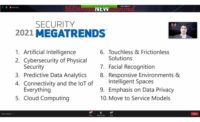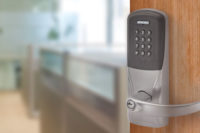The Monitoring Association continued its virtual OPS-TECH meeting on Nov. 17-18, focusing on technology.
The technology portion of TMA OPS-TECH continued with its “Mission Possible” theme, complete with virtual shades for the opening presenters. The two-day event sought to bring a focus on technology from both inside and outside the security industry.
In keeping with the theme, the opening speaker was a real-life special agent, SSA Brian Cyprian of the FBI. “As a special agent I appreciate everyone who is in security,” he said. “You help us complete our mission with the great products you provide. As a homeowner I appreciate the verification and security I get so I know when something really happens. In all honesty yours is a business of uptime, availability, and confidence.”
That uptime and confidence is what Cyprian focused on, in particular cybersecurity and the importance of having a contact and relationship with his agency.
“Do you have a point of contact at your local FBI field office if you need to have something answered?” he asked. “If not, start developing that. Do it now instead of waiting until something happens. I would encourage you to report any incidents, even if you have paid a ransomware.”
He also touched on the impact of the pandemic, particularly with more workers remoting in from home, and the distractions that can allow for a lapse in judgement in opening a phishing email — which have only increased during this period.
“A distracted workforce is the weakest link in information security,” he said. “You can have all the controls in place, and they still click on that link. This is only magnified during distractions like we have had over last few months.”
He strongly urged attendees to make sure they have an incident response plan and to make sure you know what to do if you have an incident.
Next, Morgan Hertel, vice president of technology and innovation for Rapid Response Monitoring, and Dan Turner, CIO for Per Mar Security Services held a conversation about the state of the security industry, discussing what their two organizations did to handle the pandemic. Both picked up on Cyprian’s work-from-home and distracted workforce themes.
“I consider Per Mar to have a pretty mature cybersecurity stance, but we are still getting small phishing attacks,” Turner said. “They are buying domains that are very similar to our customers’ to go after our distracted workers.”
Hertel said they have seen more phishing from what look like vendors.
Both described the overall COVID-19 experience, from the initial scramble to set up workers from home, to the ever shifting landscape of the pandemic and the rules around it, as trying to fix — or even build — an airplane while flying it. They speculated that the situation will likely continue through at least next summer.
“Now things are settling down; we have redirected technology and are trying to keep pace with keeping people at home,” Hertel said. “It is like tuning a plane while you fly, no question. I don’t’ think we will have people back in next year. We will see how the vaccine goes, but it will be like this for a while.”
Day two of OPS-TECH began with a keynote from Scott Stanton, senior director, Americas enterprise networking at Cisco. Stanton discussed the future of networking and WiFi 6 and the impact on how this technology enables IoT devices and how it fills in the gaps of LTE and 5G buildouts.
Stanton began his presentation listing the benefits of WiFi 6, which include higher data rates; security improvements and support for high density and IoT; more flexible IoT designs; and better battery life.
“Every time there’s a new Wifi standard, things get faster,” he said.
Although “things getting faster” is a plus, Stanton said Wifi 6 is able to handle more clients in a more efficient way.
“With Wifi 6, we’re able to be a lot more deterministic based on the client type,” he said
Additionally, WiFi 6 allows for better security for open WiFi-networks with encryption of unauthenticated traffic, with Stanton pointing to medical devices that are digital and WiFi enabled that need harder-to hack WPA-personal passwords, or PSKs (pre-shared key).
“This is a big deal,” he says.
Although WiFi 6 has been available for little over a year, Stanton says that its adoption has been fast in the market since its value proposition is high.
“We see at Cisco for example, over half of the axis points that we sell right now are WiFi 6,” he said.
5G goes hand-in-hand with WiFi 6, Staton said, with each technology complimenting each other.
However, the access to 5G differs from each area, with Stanton pointing out the difference of 5G availability in Manhattan and Brooklyn, with the former having more 5G spots than the latter. WiFi is a cheaper technology to implement since the cost of the silicon to create 5G technology is more expensive. 5G is better suited for outdoor implementation, like outdoor wireless and transportation, while WiFi 6 is better suited for indoor implementation, like indoor campuses and retail branches.
In the last education session, titled “Alarm Incident Scoring Standard – Applications to the Industry,” Mark E. McCall, global director of monitoring transformation at Stanley Security moderated a panel consisting of Jay Hauhn, principle of Hauhn and Associates; Larry Folsom, vice president of monitoring technology at ADT; David Holl, director of public safety in Lower Allen Township; and Morgan Hertel, vice president of technology and innovation at Rapid Response Monitoring.
The panel gave a background and overview on TMA’s AVS01 standard, data sources and scoring methodology and a public safety view of why an alarm incident scoring standard is important.
According to Hauhn, the standard was created to rebuild the confidence between public safety officials and alarm companies, using a scoring metric to estimate the validity of an alarm event to lower the percentage of false alarms.
Potential data sources for the AVS01 standard come from panel data from burglar alarms, audio data, video data from cameras, data from social media like Twitter or Nextdoor, personal data, biometric data and environmental data.
“Cash may be king, but data is golden,” he said.
The standard also allows to better judge the severity of an alarm call for proper response time.
“As an industry, unfortunately we often struggle to delineate between a four and a two,” Folsom said.
The panel then pointed to a case study of a burglary of a Yamaha dealership, where a call was received by an alarm company, who notified the emergency communications center (ECC), which dispatched to police. When the police arrived, they found no vehicles on the premise with the front door shattered. When the owner arrived to the premise and reviewed the video from the back office, the officer realized she had passed the white car and pick-up trailer not realizing it was the suspects leaving the burglary scene.
With a standards-based protocol in place, the motorcycles could have been recovered and the burglary could have been solved.
“All that enhanced information would have been critical in identifying [the burglars],” Holt said. “What we’re looking here is getting that information upfront in these responses with verified, reliable information provided.”
Like the previous week, the technology portion of OPS-TECH featured networking and engagement activities, along with a virtual exhibitor section.
All sessions for both weeks are available for up to six months to restream in Whova. For more information, visit The Monitoring Association’s website.




